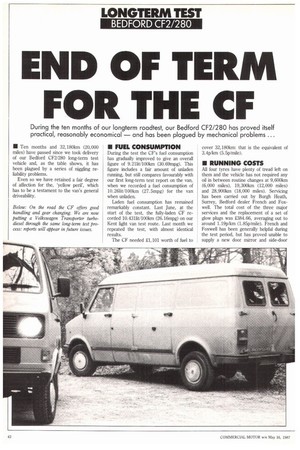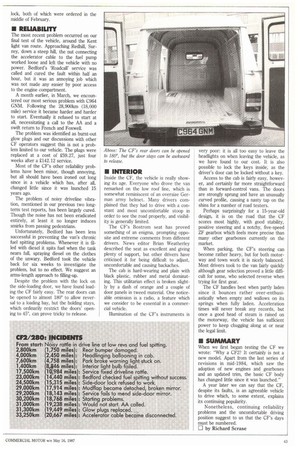END OFT
Page 44

Page 45

If you've noticed an error in this article please click here to report it so we can fix it.
ERM FORT HE CF
During the ten months of our longterm roadtest, our Bedford CF2/280 has proved itself practical, reasonably economical — and has been plagued by mechanical problems ...
• Ten months and 32,180km (20,000 miles) have passed since we took delivery of our Bedford CF2/280 long-term test vehicle and, as the table shows, it has been plagued by a series of niggling reliability problems.
Even so we have retained a fair degree of affection for the, 'yellow peril', which has to be a testament to the van's general driveability.
• FUEL CONSUMPTION
During the test the CF's fuel consumption has gradually improved to give an overall figure of 9.2111t/100km (30.69mpg). This figure includes a fair amount of unladen running, but still compares favourably with our first long-term test report on the van, when we recorded a fuel consumption of 10.261it/100km (27.5mpg) for the van when unladen.
Laden fuel consumption has remained remarkably constant. Last June, at the start of the test, the fully-laden CF recorded 10.431lit/100km (26.16mpg) on our Kent light van test route. Last month we repeated the test, with almost identical results.
The CF needed 21,101 worth of fuel to cover 32,180km: that is the equivalent of 3.4p/km (5. 5p/mile).
• RUNNING COSTS
All four tyres have plenty of tread left on them and the vehicle has not required any oil in between routine changes at 9,600km (6,000 miles), 19,300km (12,000 miles) and 28,900krn (18,000 miles). Servicing has been carried out by Burgh Heath, Surrey, Bedford dealer French and Foxwell. The total cost of the three major services and the replacement of a set of glow plugs was £384.66, averaging out to around 1.19p/km (1.85p/mile). French and Foxwell has been generally helpful during the test period, but has proved unable to supply a new door mirror and side-door lock, both of which were ordered in the middle of February.
• RELIABILITY
The most recent problem occurred on our final test of the vehicle, around the Kent light van route. Approaching Redhill, Surrey, down a steep hill, the nut connecting the accelerator cable to the fuel pump worked loose and left the vehicle with no power. Bedford's `Roadcall' service was called and cured the fault within half an hour, but it was an annoying job which was not made any easier by poor access to the engine compartment.
A month earlier, in March, we encountered our most serious problem with C964 GNM. Following the 28,900km (18,000 mile) service it became harder and harder to start. Eventually it refused to start at all, necessitating a call to the AA and a swift return to French and Foxwell.
The problem was identified as burnt-out glow plugs and our discussions with other CF operators suggest this is not a problem limited to our vehicle. The plugs were replaced at a cost of 259.27, just four weeks after a £142.12 service.
Most of the CF's other reliability problems have been minor, though annoying, but all should have been ironed out long since in a vehicle which has, after all, changed little since it was launched 15 years ago.
The problem of noisy driveline vibration, mentioned in our previous two longterm test reports, has been largely cured. Though the noise has not been eradicated entirely, at least it no longer induces smirks from passing pedestrians.
Unfortunately, Bedford has been less successful in preventing the van's chronic fuel spitting problems. Whenever it is filled with diesel it spits fuel when the tank nears full, spraying diesel on the clothes of the unwary. Bedford took the vehicle back for six weeks to investigate the problem, but to no effect. We suggest an arms-length approach to filling-up.
Despite the problem with the lock on the side-loading door, we have found loading the CF fairly easy. The rear doors can be opened to almost 1800 to allow reversal to a loading bay, but the holding stays, which ordinarily restrict the doors' opening to 450, can prove tricky to release.
• INTERIOR
Inside the CF, the vehicle is really showing its age. Everyone who drove the van remarked on the low roof line, which is somewhat reminiscent of an oversize German army helmet. Many drivers complained that they had to drive with a constant and most uncomfortable stoop in order to see the road properly, and visibility is generally limited.
The CF's Bostrom seat has proved something of an enigma, prompting opposite and extreme comments from different drivers. News editor Brian Weatherley described the seat as excellent and giving plenty of support, but other drivers have criticised it for being difficult to adjust, uncomfortable and causing backaches.
The cab is hard-wearing and plain with black plastic, rubber and metal dominating. This utilitarian effect is broken slightly by a dash of orange and a couple of door panels in tweed material. One noticeable omission is a radio, a feature which we consider to be essential in a commercial vehicle.
Illumination of the CF's instruments is very poor: it is all too easy to leave the headlights on when leaving the vehicle, as we have found to our cost. It is also possible to lock the keys inside; as the driver's door can be locked without a key.
Access to the cab is fairly easy, however, and certainly far more straightforward than in forward-control vans. The doors are strongly sprung and have an unusually curved profile, causing a nasty tap on the shins for a number of road testers.
Perhaps surprisingly for a 15-year-old design, it is on the road that the CF scores most highly, with good stability, positive steering and a notchy, five-speed ZF gearbox which feels more precise than many other gearboxes currently on the market.
When parking, the CF's steering can become rather heavy, but for both motorway and town work it is nicely balanced. Most drivers took to the van fairly quickly although gear selection proved a little difficult for some, who selected reverse when trying for first gear.
The CF handles best when partly laden since it bounces rather over-enthusiastically when empty and wallows on its springs when fully laden. Acceleration times will never break any records, but once a good head of steam is raised on the motorway, the vehicle has sufficient power to keep chugging along at or near the legal limit.
• SUMMARY
When we first began testing the CF we wrote: "Why a CF2? It certainly is not a new model. Apart from the last series of revisions in mid-1984, which saw the adoption of new engines and gearboxes and an updated trim, the basic CF body has changed little since it was launched."
A year later we can say that the CF, despite its faults, is an agreeable vehicle to drive which, to some extent, explains its continuing popularity.
Nonetheless, continuing reliability problems and the uncomfortable driving position suggest to us that the CF's days must be numbered.
by Richard Scrase












































































